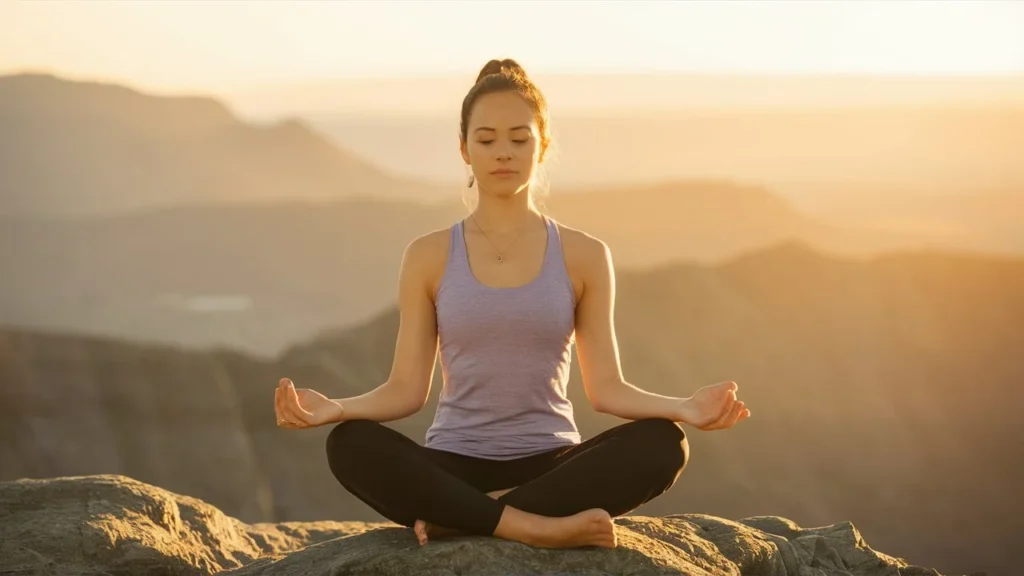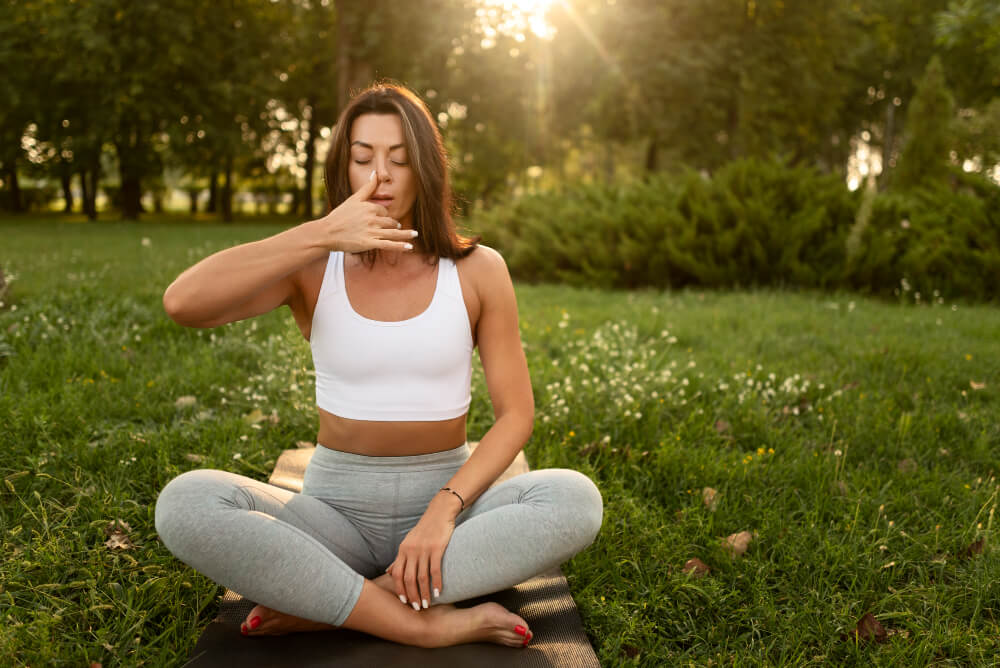
The word Pranayama is made up of two words, one of which is “Prana’ and the other ‘Ayam. Prana is radiant energy, which keeps our body alive and which gives strength to our body and mind. And “Ayam” means stretching, Pranayama yoga can be understood in this way, in which the word Prana refers to our life force, and the opposite Ayam means to do it regularly. In this extension, the word Pranayama means to regulate one’s own life force and use it properly.
By doing pranayama, we get several thousand heat energy which we call Nadi, and centers of energy like chakras are created around the body. Pranayama is very beneficial for our bodies. People always do it before the sun comes. Pranayama is one such yoga, which not only makes our body healthy but also the mind.
On the idea of this, the quantity of Prana Shakti determines the will of man, in order that he can use the energy in his many good works. the entire practice of Pranayama helps our vital force to become strong, thanks to which it always remains healthy in body, mind, and body.
If seen, there are many benefits of Pranayama, which is extremely important for our life. By doing Pranayama on a daily basis, tons of energy resides within the body. it’s very beneficial of inhaling pranayama, thanks to which the human breath becomes better than before.
What is the Meaning of Pranayama ?
Pranayama is an integral part of yoga. Controlled breathing enables both to perform yoga and to calm the mind for meditation. Pranayama is an awareness of the breath. Pranayama is the link that connects your physical yoga practices (asanas) with your mental yoga practices (dhyana).
This is a set of steps to guide your active mind through it to make you feel inner peace. Pranayama is a Sanskrit word which is made up of two words in which the first word is “Prana” meaning “breath” (life force) and the second word “Ayam” which means “control” (extension). If you do Pranayama regularly then it heals our body internally.
Types of Pranayama
- Pranava Pranayama
- Sheetali Pranayama (Cooling Breath)
- Ujjayi Pranayama
- Kapalbhati Pranayama
- Dirga pranayama
- Bhastrika Pranayama
- Bahya Pranayam
- Bhramari Pranayama
- Udgeeth Pranayama
- Anulom-Vilom Pranayam
- Agnisar kriya pranayama
1.Pranava Pranayama
Pranava Pranayama is a very powerful posture in which we all sit in Sukhasana, Siddhasana, Padmasana, Vajrasana and the person has to sit quietly in his mind and take long breaths and chant om so that his peace can be achieved. and mix with the environment. Talking about the benefits, doing this asana is controlled by positive energy, benefits psychic pants, and gives peace of mind.
2.Sheetali Pranayama
The word “Sheetli” means “cooling”, that is, a process that will calm our body and provides a sense of coolness. The daily practice of Sheetali Pranayama calms the mind. the essential purpose of Sheetali Pranayama is to extend blood heat which features a positive effect on our systema nervosum and endocrine glands.
Practicing this pranayama makes an individual young and attractive and its daily practice enables you to regulate thirst and hunger. Sheetali Pranayama is somewhat almost like Sheetkari Pranayama and both are mentioned within the ancient text “Hatha Yoga Pradeepika”.
3.Ujjayi Pranayama
Ujjayi Pranayama is named after a Sanskrit word meaning victory, “Victorious.” That’s why it is also called Victorious Breath. While doing Ujjayi Pranayama, the sound sounds like the ocean; hence it is also known as Ocean Breath. It is this pranayama that frees us from bondage.
Ujjayi Pranayama is a breathing exercise that helps to calm your mind by focusing on your “breath”. This helps you to override thoughts that may be distracting from your meditative state.
Also, Read ⬇️ ⬇️
Ujjayi Pranayama Benefits and Steps
4.Kapalbhati Pranayama
While doing this asana, we have to throw the breath outwards and bring the stomach inwards. In this posture, we have to exhale only and if we breathe in this posture, then we will do this posture wrong.
We have to breathe only when we get space between two breaths. We do not have to breathe in intentionally, otherwise, we will have to face his difficulties. This asana is called Kapalbhati because it uses both the brain and the light equally. And Kapalbhati is a very easy yoga from another ashram.
The thing to be known is that while doing this asana, we have to concentrate which is not very difficult but easy. Many great people have said that while doing Kapalbhati, we have to think that all the bad energy is going from our body and good powers are being felt.
Also, Read ⬇️ ⬇️
Benefits of Kapalbhati Pranayama and the way to Do It
5.Dirgha pranayama
Dirgha Pranayama is an incredible breathing activity that encourages professionals to carry their breathing to flawlessness. It encourages individuals to take such that the air arrives at the mid-region and oxygen-rich blood courses all through the entire body.
It can have a big transformative impact on the body and psyche accordingly ensuring that a private can accomplish internal recuperating. Dirgha Pranayama is otherwise called a three-part breathe.
Also, Read ⬇️ ⬇️
Dirgha Pranayama (Three-Part Breathing): Steps & Benefits
6.Bhastrika Pranayama
While doing this asana, we should sit in Sukhasana, Siddhasana. Many sages have told us that while doing this asana, we should sit in these positions only. We have to take a long breath through the nose and keep exhaling through the nose, the thing to know is that while breathing, we need to remain calm.
Many people make a lot of mistakes like they do not take a full breath while breathing due to which they may have to face a lot of trouble. Many scientists have told us that the first nose and second mouth in our body for inhalation and exhalation. Which purify our air and half the effect of air is energy in the whole body, due to which there is no shortage of oxygen to the human being.
Also, Read ⬇️ ⬇️
Bhastrika Pranayama Benefits, Steps, and Precautions
7.Bahya Pranayam
While doing this asana, we should sit in 3 positions. In this, after exhaling the breath completely, we have to hold the breath out and all three are closed.
- Jalandhar Bandha
- Udyan Bandh
- Moola Bandha
8.Bhramari Pranayama
Before doing this asana, we should sit in Sukhasana, Siddhasana, Padmasana, Vajrasana and the ears should be completely closed with both thumbs. Keeping two fingers of the hands-on the forehead, keep six fingers on both the eyes and move in darkness.
Doing this regularly creates positive energy. Benefit the psychic patient. There is a panacea treatment for many diseases like migraine pain, depression, and to eradicate all the opponents related to the brain. It seems that doing this gives peace of mind and brain which is important for human beings.
10.Anulom-Vilom Pranayam
To do this asana, we have to sit in Sukhasana, Siddhasana, Padmasana, or Vajrasana. The beginning and end of the precious antonym should always be done with the left nostril and, close the right nostril of the nose and take a long breath from the left. happens |
After the asana, then closing the left, long exhalation from the right one and now take a long breath from the right and it is necessary to release from the left one.
Also, Read ⬇️ ⬇️
Anulom Vilom Pranayama Benefits
11.Agnisar kriya pranayama
While doing this asana, we have to sit in Sukhasana, Siddhasana, Padmasana, Vajrasana. While sitting, the action is not at all like Kapalbhati Pranayama, one does not have to exhale again and again and after exhaling the breath completely, by stopping it. It is necessary to move the stomach back and forth which is the correct method.
Talking about benefits, all the problems of stomachs like constipation, acidity, gastric, get eradicated by doing this asana. Hernia completely disappears if we do this asana and all the problems related to dhatu, and urination disappear. This asana helps to concentrate the mind.
How to do Pranayama Yoga
- Sit quietly for a minute. Inhale and release normally.
- During this one minute, think that you are going to get energy in body and mind to be healthy and strong.
- Think that you are going to remove all the impurities of the mind through breathing and you are going to get energy and soul with breathing.
- Think that the breath you take will be external to life, strength, positivism, and energy.
- Close the eyes, focus the vision on the nose, keep the back straight, and calm the mind.
- Take a deep breath, very slowly, do not rush. Think that you are filling energy and life in the mind and body.
- Exhale slowly. The duration of exhalation should be the same as the duration of breathing. While exhaling, think that all the faults of your body and mind are coming out.
- Repeat 10-20 times as per your convenience.
Pranayama Yoga Benefits
- Practicing Pranayama helps relieve stress, asthma, and stutter-related disorders.
- Depression can also be treated with Pranayama.
- The practice of Pranayama brings a steady mind and strong will power.
- Apart from this, by doing regular pranayama one gets long life.
Also, Read ⬇️ ⬇️
Which people should do Pranayama Yoga Regularly?
Pranayama plays a very important role in our life. Every human should do Pranayama regularly. For those people who have complaints related to breathing, Pranayama is a panacea for those people. By doing this pranayama, he can control his breath, and can also hold his breath for a long time. Pranayama is very easy for people who are suffering from depression.
There are many people in the world who are complaining about their backbone, Pranayama is a panacea treatment for such persons so that they can overcome all the problems related to their bones. If we are suffering from depression, then pranayama is also the basic treatment for it(1). Therefore, pranayama should be done by people of all ages.
What Precautions Should be Taken in Doing Pranayama Yoga
To practice Pranayama safely and effectively, consider the following precautions:
- Empty Stomach: Practice on an empty stomach, preferably in the morning or several hours after meals.
- Gradual Progression: Start with simple techniques and gradually progress to more advanced practices under the guidance of a qualified instructor.
- Individual Considerations: Adjust the practice according to your health condition, avoiding techniques that may strain or cause discomfort.
- Consistency: Maintain a regular practice schedule to experience sustained benefits over time.
- Expert Guidance: Seek guidance from a certified yoga instructor or healthcare professional, especially if you have pre-existing health concerns or conditions.
Incorporating Pranayama into your daily routine can significantly enhance your physical and mental well-being. Whether you’re new to yoga or an experienced practitioner, exploring different Pranayama techniques can deepen your practice and enrich your life.
Conclusion
In conclusion, Pranayama Yoga offers profound benefits for both the body and mind. By understanding and practicing different types of Pranayama, individuals can enhance their overall well-being, from improving respiratory health to fostering mental clarity and inner peace. Regular practice under proper guidance ensures optimal benefits and should be approached with mindfulness and respect for individual health conditions. Embrace Pranayama Yoga as a holistic practice to harmonize your life force and achieve enduring vitality.


